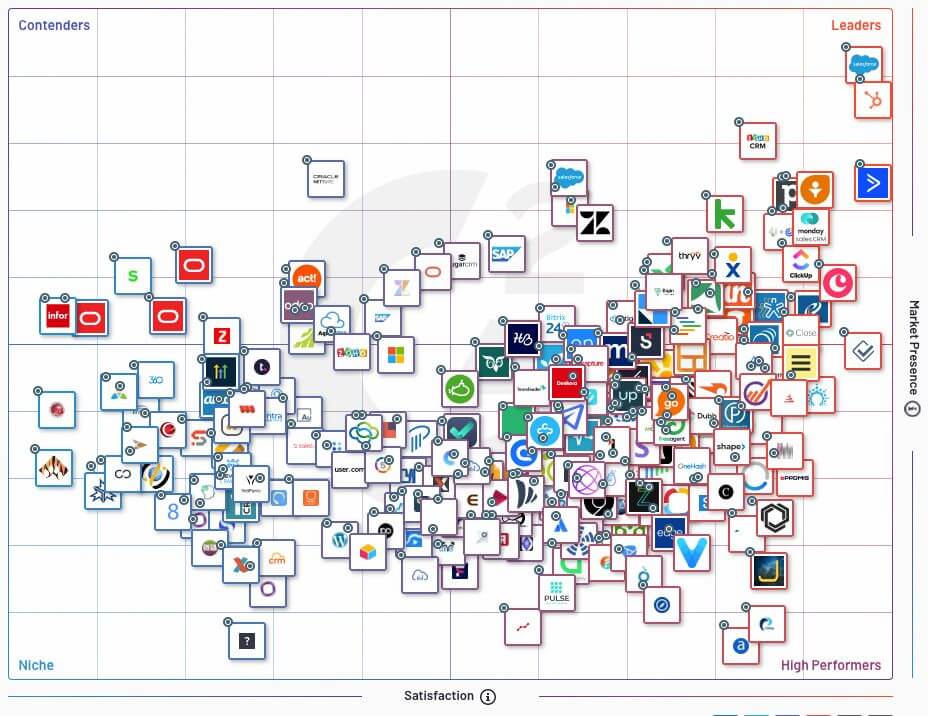How to create the ultimate go-to-market strategy
It’s brutal out there.
Whether you’re launching a new business or a new product, competition is fierce, resources are limited, and market preferences can change in a moment.
Just look how crowded the G2 Grid® for CRM is:

With over 700 companies competing in this highly saturated market, getting lost is easy. Hence, every business that wants to grow needs direction in the form of a go-to-market strategy.
A go-to-market strategy framework is a blueprint for growth. It’s a living document that keeps your teams focused and aligned and helps you meet your goals.
Whether it’s your first time creating a go-to-market strategy or your tenth, this article will teach you everything you need to know to be successful.
What is a go-to-market strategy?
A go-to-market strategy is a detailed step-by-step plan that provides a clear roadmap for launching a product into a market.
However, a go-to-market plan isn’t just used to launch new products. You can also use them to promote an existing product in a new market.
Go-to-market strategies can vary from company to company. But they generally include a thorough analysis of your product’s place in the market, prospective customer segments, product messaging, pricing, and other marketing initiatives.

That also means that you can’t re-use an existing go-to-market (GTM) strategy for different products. Each product and market will present different opportunities and challenges. Your GTM needs to be tailored to each situation in order to be effective.
How is a go-to-market strategy different from a marketing strategy?
A go-to-market strategy is not the same as a marketing strategy. A marketing strategy explains how a company will advertise a product to target audiences. In contrast, a go-to-market strategy explains why the company is launching that product in the first place.
While a GTM strategy can overlap with a traditional marketing strategy in the latter stages of the plan, it tends to be substantially more thorough.
A marketing strategy will also change significantly over time, while a GTM strategy will stay the same unless you launch a new product, enter a new market, or experience substantial growth.
What are the benefits of a go-to-market strategy?
With most new products failing in the market, you undoubtedly need a strategy to put your product in the top one percent. A thorough go-to-market plan can help you achieve this and more.
It clarifies why you’re launching a product
Most products fail because there isn’t a strong demand for them. A go-to-market strategy will stop you from falling into that trap by forcing you to define your target audience’s specific problems and how your product solves them.
It minimizes risk
Because a go-to-market strategy carefully defines the challenges the product solves and the target audiences who will buy it, there is far less chance of it failing. If you can’t prove demand at the start of your GTM, you don’t make the product to market.
It reduces time to market
A clear and systematic strategy makes it much quicker to take a product from research to development to market. You’ve already done a lot of the hard work upfront, and with a marketing plan already in place in the GTM, it’s simply a matter of executing well.
It puts more focus on the customer
As you’ll see, the customer lies at the heart of your go-to-market strategy. Every decision must be made from the customer’s perspective, which means their pain points are never out of sight or out of mind.
It leads to better, cheaper marketing
Your go-to-market strategy outlines how you’ll promote your product. Not only that, but all the research into preparing it will make your marketing significantly more effective and cost-efficient. Since you can explain exactly who your target audiences are and the problems they suffer from, you can target them much more quickly and for way less ad spend.
It aligns the entire go-to-market organization
Isn’t it easier when everyone is reading from the same playbook? A go-to-market strategy does precisely that. Everyone in your GTM team, from marketing to sales and customer success, can use it to understand the unique value of your product and the reasons behind things like your pricing strategy and marketing efforts. There’s no confusion, and everyone can work together as one to drive exceptional results.
The two types of go-to-market strategies
Before you sit down to create a go-to-market strategy, you need to decide what will be the primary driver of growth — your sales team or your product.

There’s no right or wrong answer here. Both approaches have built successful businesses. But you need to pick one to create an effective GTM strategy.
Sales-led go-to-market strategy
Salespeople are at the heart of a sales-led go-to-market strategy. While every great salesperson needs a good product (and the product will still be an essential part of any sales discussion), the sales representatives initiate and close sales.
Sales-led strategies are particularly effective for complex B2B products sold into enterprise companies with multiple stakeholders. These products usually aren’t self-explanatory and require a salesperson to match specific features and benefits to a prospect’s needs. Sales staff also navigate through the multiple decision-makers, keeping everyone on the same page and ensuring everyone gives their approval.
The longer your sales cycle and the more resources it requires, the more critical it will be to have a sales-led strategy.
Product-led go-to-market strategy
Conversely, a product-led go-to-market strategy centers around your product. It isn’t just the solution to your buyer’s needs; it also acts as your lead salesperson. It is self-service in nature, and customers can demo, buy, upgrade and cancel a product without speaking to a salesperson.
Product-led go-to-market strategies tend not to have big sales teams (if they have them). Instead, investment is made in marketing and customer success. With a product-led strategy, it’s much more important to make buyers aware of your product and teach them how to use it than to have someone trying to reach out to them every week.
This strategy is effective for Software-as-a-Service (SaaS) products that provide a relatively simple user experience and don’t cost the earth. Typically, one person can decide to buy a SaaS tool, and getting budgetary sign-off will be simple if it’s required.
How to create a comprehensive go-to-market strategy
Below, we’ll walk through the seven steps to creating an all-encompassing go-to-market strategy. For clarity, let’s assume that you’re making a GTM for a B2B product, although B2C brands can follow the same steps.
1. Identify product-market fit
Every great product launch solves a specific problem. Unfortunately, most product launches don’t. The number two reason startups fail is that they tackle exciting problems rather than those that serve a market need.
With that in mind, you need a clear understanding of your product’s value and the problems it solves, before you can create the rest of your go-to-market strategy.
Pay particular attention to product-market fit — how well your product satisfies demand in the market. Product-market fit research should focus on two things:
- The customer pain points your product solves
- The outcomes customers can expect from your product
You can resolve customer pain points in several ways. Clearly stating the results, your product promises can help you identify how well your product meets your potential customer’s desires.
Suppose your research shows that your product solves a specific problem. Great. You’ve got product-market fit and can continue with development.
But all isn’t lost if it doesn’t. You can adjust your product so that it does solve a market need or test out a different target market instead.
In either case, it’s worth spending a lot of time and money at this stage of your GTM strategy. In many cases, this stage will tell you if your product will be a hit or a flop before you create the product.
2. Define your target market
You need to clearly understand your target market to have a successful GTM launch. You can’t market to everyone. The better you can define your ideal customer, the easier and cheaper it will be to reach them.
The best way to define your target audience is to understand the problems your product will solve (which you’ve done above) and then think about the people most likely to suffer from these problems.
There may be more than one type of person who suffers from the problems your product solves. If that’s the case, you’ll need to define more than one target market.
Competitor research is a valuable strategy to use here. If your product already has established competitors, they’ll probably have very obvious target audiences. Understand who these people are and see if they are a good fit for your product.
Once you clearly understand the types of people you should target, create an Ideal Customer Profile (ICP) for each of them.

An ICP is a detailed description of your perfect prospective customer. A B2B ICP may include the following information:
- Their job
- The industry they work in
- The size of their company
- Their location
- Their tech stack
- Their specific challenges
Analyze data about your customers and consider conducting interviews. Then identify common attributes that your existing customers share to get a clearer picture of your target audience.
3. Develop your messaging
With your target audiences established, you can move on to creating your value proposition and brand messaging.
You’ll want to start by defining your Unique Value Proposition (UVP). Your UVP is a statement that describes why your product is the best on the market and the specific value it offers customers.
Next, you’ll want to develop your brand messaging to clarify your position in the market. Are you a premium, complex, enterprise-level brand? Or are you the more agile and cheaper alternative?
Your brand messaging must make this clear to everyone, particularly your target audiences. The good thing about carefully defining your target market is that it makes it much easier to tailor your messaging to them to increase conversions.
If you have more than one target audience, tailor your brand message to each audience.
If in doubt, sharpen your talk tracks using Gong. You can listen to recordings of sales demos or shadow the sales reps live, to better understand the language your prospects use about their pain points.
When you think you’ve perfected your messaging, put it to the test by advertising it on a platform like Google Ads. Higher-than-average clickthrough and conversion rates signal you’ve got the tone spot-on.
4. Create a pricing strategy
Pricing can make or break your product. Price too high or even too low, and your target market could snub your product. It’s why it’s essential to spend research time finding your pricing point’s Goldilocks zone.
Much of the target audience research you collated in the first few stages will be useful here. So will any competitor research.
Remember, pricing is much more than just a financial decision. It impacts your brand positioning and communicates the quality of your product, among other things. It will also influence your marketing efforts. The more premium your product, the more you can spend per acquisition and still break even. The channels you use to advertise will change too.
5. Choose your sales and distribution model
Before creating a marketing strategy, you need to know where your potential customers can purchase your product and how it will get to them.
There are two distribution models: an indirect distribution model and a direct distribution model.
Indirect distribution models rely on third parties like vendors, wholesalers, and retailers to get your product into customers’ hands. Direct distribution models are company owned and operated (think software companies and DTC eCommerce brands).
For most B2B companies, the sales and distribution channels will be the same — customers will buy directly from your brand. That’s not always the case, of course. Some software developers will sell through third parties.
6. Craft a promotion and sales strategy
This is the stage of your go-to-market plan that most closely aligns with your marketing strategy. Your promotion strategy is a blueprint of how you plan to promote your product to your target customers.
The way you target your customer will depend on your target audience and your GTM strategy. Ask yourself where you can find your ICP. How do your competitors reach their ICPs? How much budget do you have?
If you are using a sales-led approach, you’ll probably choose to invest heavily in the outbound methods listed below like an inside sales team and online ads. Product-led strategies are better for smaller marketing budgets and will focus on the inbound methods mentioned below, like content marketing.

Your promotion strategy must cover each stage of the buyer’s journey. Each phase needs different types of content, ads, and plans – so outline what that will look like.
Content will need to grab your target customer’s attention towards the top of the funnel (at the awareness and interest stages). Blogs and videos work great here. But your sales representatives can also capture prospective buyers at this funnel stage when they are just expressing an awareness of a problem.
In the middle of the funnel, content needs to show how your new product can solve the specific pain points of your ICPs. Here is where your sales reps will educate and pitch their prospects and where pieces of inbound content like case studies and ebooks work best.
The nearer they are to the bottom of the funnel, the more direct your content and advertising messages can be and the more you can spend to convert a single customer.

Don’t forget about the very bottom of the sales funnel, either. Ensure you have an onboarding plan and a strategy for creating customer success. Your promotional strategy shouldn’t stop with the deal closure. It should also explain how you can turn a customer into a promoter.
You’ll also need to adapt to your technology adoption lifecycle. As Geoffrey Moore, author of Crossing the Chasm, explains, different stages of technological evolution have different personas and require different sales strategies.

For instance, you don’t need a lot of data to sell to early adopters. They operate on gut instinct. However, the further along the life cycle you get, the more data-driven your sales and marketing efforts need to become.
7. Set clear, measurable goals
Every great go-to-market strategy has clear, measurable objectives. Without them, it will be hard to tell if your strategy is working. Think carefully about the targets you want to achieve from your GTM strategy.
Do you want to sell a certain number of products in a certain timeframe? Reach a particular market cap? Hit a valuation target?
Whatever your goal, make sure it is achievable and measurable. The goals you pick at this stage will inform the metrics you track and use to improve your GTM strategy once it’s live.
Tracking and improving your GTM
Your GTM strategy is not a one-and-done project. Measuring your success and reviewing the strategy as necessary, is essential if you’re to keep growing.
Once you’ve set goals for your GTM, identify half a dozen KPIs and other metrics to track your success. You’ll want to make sure these are directly related to your goals. Some common KPIs include:
- Customer acquisition cost
- Average revenue per customer
- Length of sales cycle
- Conversion rate
- Burn rate
These metrics become meaningless if you don’t check in on them regularly and tweak your GTM strategy accordingly. Create a process for automatically tracking these KPIs and set aside time each week to review them. Share the results with your team and act accordingly if your GTM isn’t living up to expectations.
Warning: GTMs don’t work through multiple growth phases
Unfortunately, you can’t have too much of a good thing. When a go-to-market strategy works well, there’s a tendency for stakeholders to think of it as an enduring formula that will guide the company indefinitely into the future.
That’s rarely the case.
When your company is growing rapidly, things are constantly in flux. Your product will almost always expand and change, new markets will open up, and others may become closed off entirely. As you reach new audiences, more competitors will emerge and competition will increase significantly.
To succeed in the long run, you need to understand that your GTM is a dynamic model that must change over time. Don’t wait for change to be forced upon you. Be proactive by:
- Constantly testing and measuring your GTM
- Pushing customer-fit boundaries
- Use a revenue intelligence platform to automate decisions
Go-to-market faster with Gong
A good go-to-market strategy paves the way for faster growth. A great one adopts technologies to help your product and business grow even faster.
A revenue intelligence platform like Gong can help your GTM team automate processes so they can focus on high-value tasks. It can also help you integrate across functions to keep your team aligned. Besides, you can use the platform’s real-time insights to inform and optimize your go-to-market strategy.
And while you’re at it, why not equip yourself with our High Growth Sales Strategy template? It will help you build out many elements mentioned in this guide, including ICPs, sales processes, and revenue strategies.

